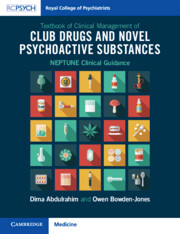 Textbook of Clinical Management of Club Drugs and Novel Psychoactive Substances
Textbook of Clinical Management of Club Drugs and Novel Psychoactive Substances Book contents
- Textbook of Clinical Management of Club Drugs and Novel Psychoactive Substances
- Textbook of Clinical Management of Club Drugs and Novel Psychoactive Substances
- Copyright page
- Contents
- Acknowledgements
- Part I Introduction and Background
- Chapter 1 An Introduction to Club Drugs and Novel Psychoactive Substances
- Chapter 2 Psychosocial Interventions for Club Drugs and Novel Psychoactive Substances
- Part II Drugs with Primarily Depressant Effects
- Part III Drugs with Primarily Stimulant Effects
- Part IV Drugs with Primarily Hallucinogenic Effects
- Part V Synthetic Cannabinoid Receptor Agonists
- Part VI Concluding Remarks
- Index
- References
Chapter 1 - An Introduction to Club Drugs and Novel Psychoactive Substances
from Part I - Introduction and Background
Published online by Cambridge University Press: 06 October 2022
- Textbook of Clinical Management of Club Drugs and Novel Psychoactive Substances
- Textbook of Clinical Management of Club Drugs and Novel Psychoactive Substances
- Copyright page
- Contents
- Acknowledgements
- Part I Introduction and Background
- Chapter 1 An Introduction to Club Drugs and Novel Psychoactive Substances
- Chapter 2 Psychosocial Interventions for Club Drugs and Novel Psychoactive Substances
- Part II Drugs with Primarily Depressant Effects
- Part III Drugs with Primarily Stimulant Effects
- Part IV Drugs with Primarily Hallucinogenic Effects
- Part V Synthetic Cannabinoid Receptor Agonists
- Part VI Concluding Remarks
- Index
- References
Summary
This document provides a new edition and an update to the 2015 NEPTUNE guidance on the clinical management of harms resulting from acute intoxication and from the harmful and dependent use of ‘club drugs’ and ‘novel psychoactive substances’ (NPS).
- Type
- Chapter
- Information
- Textbook of Clinical Management of Club Drugs and Novel Psychoactive SubstancesNEPTUNE Clinical Guidance, pp. 1 - 21Publisher: Cambridge University PressPrint publication year: 2022


